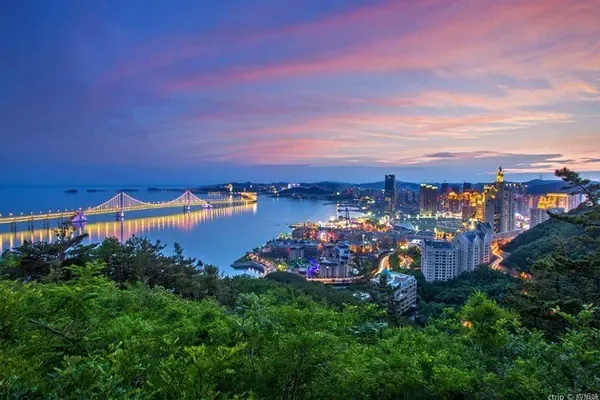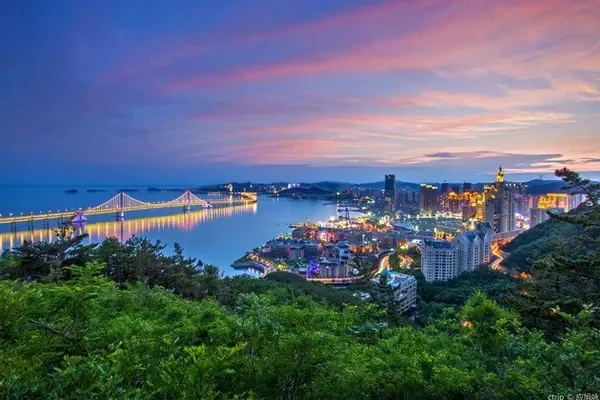In late July 2021, during my trip to Ningxia, I visited Shuidonggou scenic spot. The picture shows a commemorative photo I took in Shuidonggou Scenic Area.
Shuidonggou Scenic Spot is located in Linhe Town, Lingwu City, Ningxia, 19 kilometers away from Yinchuan City in the west, 30 kilometers away from Lingwu City in the south, and 11 kilometers away from Hedong Airport. The picture shows the panoramic view of the tour guide of the Shuidonggou Ruins Scenic Area.
Shuidonggou is the earliest Paleolithic cultural site excavated in China, with a history of more than 50,000 years. It is known as "the birthplace of Chinese prehistoric archaeology" and "the historical witness of the cultural exchange between China and the West". Shuidonggou's unique historical stone carving gate is impressive.
Shuidonggou is a national key cultural relic protection unit, a national AAAAA-level tourist attraction, and a national geological park. It is listed by the state as one of the 100 national cultural relics protection sites and one of the "100 most significant archaeological discoveries of Chinese civilization". Won the silver award of "China's 50 Most Worthy Places for Foreigners to Visit". The picture shows the landmark monument of the Shuidonggou site.
After visiting the Shuidonggou Ruins Museum, we first came to Zhangsan’s shop. Before the excavation of the Shuidonggou site, Zhangsanxiaodian was the only carriage and horse shop at the foot of the Great Wall, and it was the only place for tourists to cross the Yellow River to Inner Mongolia, Shanxi.
In 1920, Kent, a Belgian missionary, went from Yinchuan, Ningxia to Shaanxi, passing through here, and stayed overnight in Zhangsan Xiaodian. When he was enjoying the cool in the open space outside the store, he accidentally discovered a strange phenomenon of phosphorous fire flashing on the cliff on the other side of the Qingshui River. The next day he climbed half of the cliff and collected a woolly rhinoceros skull fossil and some stone tools. Since then, the prelude to the excavation of the Shuidonggou site has been opened.
In 1923, French paleontologists Derichin and Sang Zhihua discovered prehistoric cultural sites here. Through excavation, a large number of stone tools and animal fossils were unearthed. Therefore, Shuidonggou became the earliest ancient human cultural site discovered in the Paleolithic Age in my country. . The picture shows the statues of Kent, Teiljin, Sang Zhihua and others in Zhang San's shop.
Not far from Zhangsan's shop is Shuidonggou Village, which is a semi-crypt building complex, half above ground and half underground, with the characteristics of warm in winter and cool in summer. The locals call it "Diwozi". Shuidonggou Village is currently under maintenance and cannot be visited.
Leaving Zhangsan's shop, we first took the shuttle bus.
The ferry took us to Luhua Valley. Unexpectedly, there is such a beautiful scenery hidden in the wilderness and canyons all over the mountains and plains!
To the north of Luhua Valley is the ruins of the Great Wall built by the Ming Dynasty 500 years ago. Go up the Gobi platform along the "step by step" steps.
There are mountain temple ruins here. There are only a few big stones left in the ruins of the Shanshen Temple, but there is a huge stone standing beside the ruins, which reads "If you don't reach the Great Wall, you are not a good man",
There are the Great Wall of the Ming Dynasty, beacon towers, castles, piers and so on. It is currently a national key cultural relics protection unit.
This is the introduction of Beacon Tower
This is a brief introduction to the Ming Dynasty Great Wall
This section of the Great Wall, also known as the East Wall, was a barrier against Mongolian cavalry going south in the Ming Dynasty.
This section of the Great Wall is also the dividing line between Ningxia and Inner Mongolia.
The castles and piers of the Great Wall are magnificent, but there are many traces of later restoration.
Standing on the Great Wall, you can see Yuanyang Lake connected to Luhua Valley.
Standing on the Great Wall, you can have a panoramic view of the Mu Us Desert in the north and the Shuidonggou Scenic Area in the south.
Beacon tower overlooking the Great Wall of Ming Dynasty
Reed Flower Valley is a deep ditch gorge, also an ancient clear water channel, and the ditch is full of reeds. The picture shows a view of the Reed Flower Valley.
Walk along the plank road to the water blocking stone dam at the end of Luhua Valley, where there are rippling blue waves, cruise ships shuttle back and forth, this is Hongshan Lake.
There is the famous "Waterfront Great Wall" beside Hongshan Lake. This is the only landscape in China where the lake is connected to the Great Wall.
At the Hongshan Lake cruise ship dock, we boarded an antique cruise ship. Take a boat trip to Hongshan Lake, see the Great Wall, beautiful shadows in the cliffs, and see the blue sky and white clouds under the water, which is very interesting.
There are many fish in Hongshan Lake
The cruise ship arrived at Shazaowan Wharf, and we boarded the "musle cart" pulled by mules at Hongliu Beach.
The "Mule Cart" pulled us to the Ostrich Paradise. Ostrich Paradise is backed by the Ming Great Wall with its earthen wall and cliff.
I also saw some red deer here, with long and many antlers, very cute.
Leave the Ostrich Paradise and take a camel cart to the Grand Canyon.
When we arrived at the Grand Canyon, camel carts could no longer enter the valley.
This is a naturally formed canyon, with rock walls on both sides more than ten meters high. It is also an important part of the "deep ditch and high fortress" defense system of the Ming Great Wall. Shuidonggou is not only the place where ancient humans thrived 30,000 years ago. It was also an important military defense site for the frontier fortress in the Ming Dynasty. The Great Wall, ditches, castles, the steep Grand Canyon and the caves for Tibetan soldiers dug along the cliffs of the canyon form a three-dimensional military defense system.
This is the "tea horse market" in front of the Cangbing Cave, which provides the soldiers in the Cangbing Cave with the necessary daily necessities.
About to enter the Tibetan soldier cave. This is the guide of the Cangbing Cave.
The so-called Tibetan soldier cave is the tunnel where the nearby defenders move from the ground to the ground, conceal the army, protect themselves, wait for an attack, or set up an ambush in an open place. This is indeed a complete ancient three-dimensional military defense system. The picture shows the entrance to the cave.
Entering the cave, tunnels, organs, traps, hidden weapons, watchtowers, arsenals, wells, general lounges, meeting rooms, kitchens and other facilities are all available. The picture shows the trap in the Tibetan soldier cave.
This is the entrance to the No. 2 Cave of Zangbing Cave
Entering the Zangbing Cave, there is only a faint light, and the dark artificial cave is winding in the hanging wall, connecting up and down, and connecting left and right. There are bifurcations in the cave, which turn left and right, just like a maze. The picture shows the meeting hall of the Tibetan Bing Cave.
There are many places with the Great Wall in our country, but the three-dimensional military defense system composed of the Great Wall, ditches, castles, the steep Grand Canyon, and the Tibetan soldier caves dug along the cliffs of the canyon is only found in Shuidonggou. The picture shows the grain unearthed in the Tibetan soldier cave.
This is the porcelain unearthed in the Tibetan soldier cave
Weapons Unearthed in the Cave of Tibetan Soldiers
Weapons Unearthed in the Cave of Tibetan Soldiers
After coming out of the Tibetan soldier cave, we entered Hongshan Fort. Ningxia Great Wall Museum is built in Hongshan Fort.
A brief introduction to the Ningxia Great Wall in the Ningxia Great Wall Museum.
Leaving the Ningxia Great Wall Museum, you can reach the east gate of Hongshan Fort along the boardwalk.
Hongshan Fort is an important barrier in the defense system of the Great Wall in the Ming Dynasty. It was first built in 1503.
Exit the fort from the urn at the east gate of Hongshan Fort, outside the fort there are trenches several feet in width and depth.
When we came to the sightseeing driveway opposite the trench, we took a luxury "caravan" pulled by a tractor. This peculiar means of transportation sent us back to the exit of the scenic spot.


